Telemetry Readers
The telemetry readers are tools that pull the information from the telemetry stream, post-processes it, and allow sending single values to HH Data Management via the DMI plugin in HH Timing. There are different applications to use depending on your telemetry system, but the general operation of each software is the same. If you need access to the telemetry readers please contact us and we will make it available for download on from the website.
Supported Telemetry Systems
- Pi using the DAE Real-Time Reader
- Motec using the i2 API
- Bosch WinDarab using the BMS2Api
Pi Rt Reader
- Pi_Data_Access_x64_8.10 or later installed on the computer
- DAE Real-Time Reader license
MoTec Telemetry Reader
- MoTec i2 pro running on the computer
- MoTec i2 API license
Bosch WinDarab Telemetry Reader
- Bosch BMS2Api license
Settings
The settings page is divided into four sections.
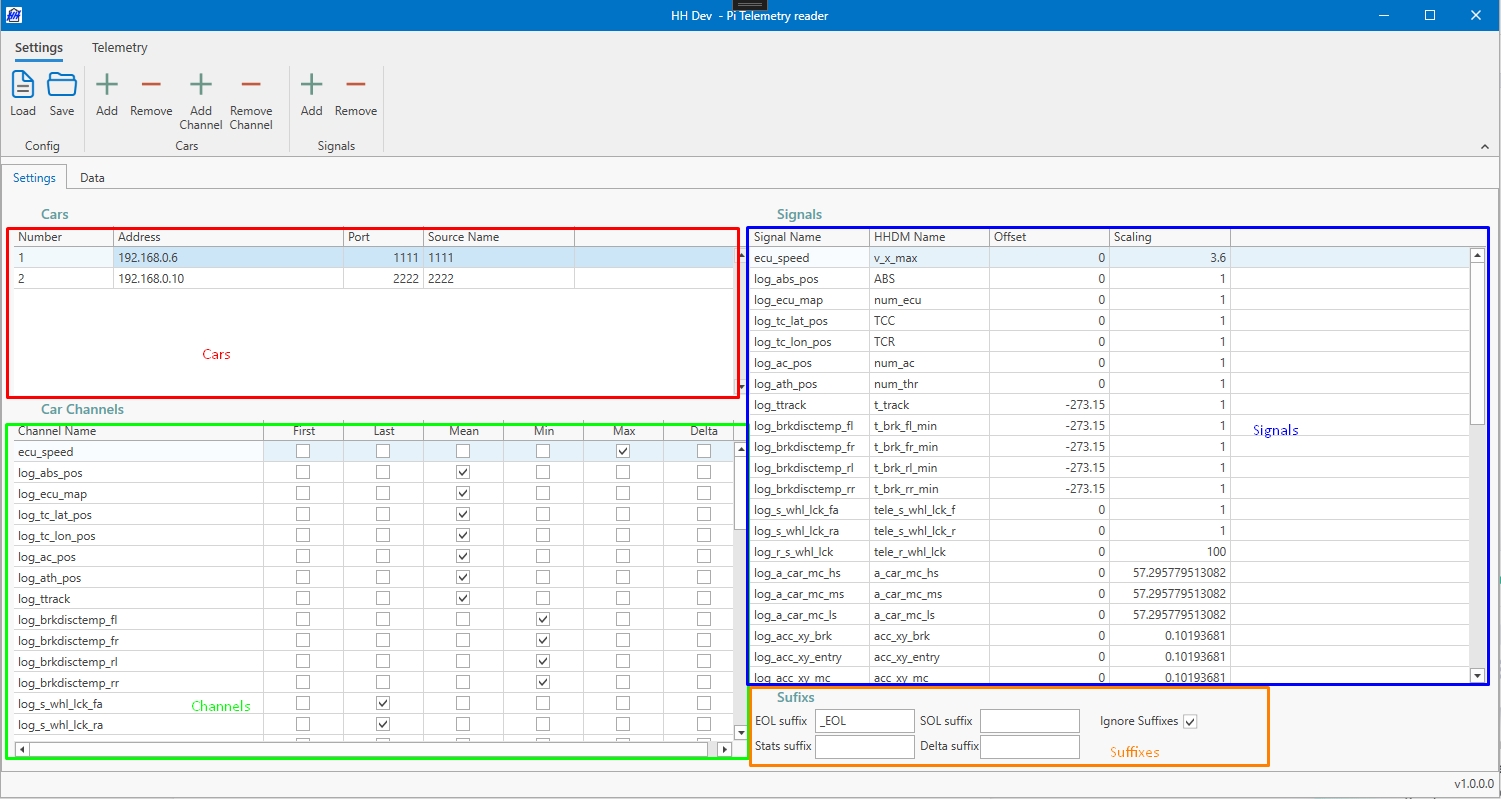
Cars
Each car is one telemetry connection. Car number is the number that will use the DMI to identify each car and should match the value in HH Timing.
Pi Connection Settings
Host and port are required to establish the connection. If named sources are used, the Source Name must be supplied.

If you are using the Pi Broadcast mode, then:
- be sure to select the 'Use broadcast connection' button in the ribbon bar
- when entering the address, two IP addresses are required, separated by a semi colon: <local adapter IP>;<source machine IP>
- the port and source name are not used
Motec Connection Settings

Bosch WinDarab Connection Settings
Address and source name for the telemetry file are required.
To find the correct settings navigate to "C:\Bosch\WinDarab\Config\WDServer" folder and look at the .bmswds file name structure

Channels
Each channel corresponds to a data channel that wants to be stored and transmitted to Data Management. The name must match the name in the telemetry stream. The tool also allows the possibility of performing statistical operations. These operations are performed on the values over a lap (Min returns the minimum of the channel in the current lap). Multiple operations can be assigned to a channel at the same time.
Signals
This is the mapping between the data name and Data Management parameter name. The tool allows unit management by using offsets and multipliers applied to the raw channels. A LapIndicator signal is needed, this signal will trigger the statistical calculation and the DMI data refresh. A lap parameter for the lap indicator is not needed in Data Management (see the DMI sections to ignore channels).
Suffixes
These are modifiers applied to the Data Management parameter name to differentiate between different statistical operations from the same data channel. The EOL suffix is applied to the calculation of the Last value of a channel. The stats suffix is for the other operations (Min, Max, Mean). The final name of the parameter in Data Management for stats operations is HHDMName{StatsSuffix}{Operation}. For example, the parameter for the minimum of the BrakeBias channel in the example above has to be named "BrakeBias_StatsMin" and the last "BrakeBias_EOL". Both suffixes can be left empty. In that case, the parameters will be sent as "BrakeBiasMin" and "BrakeBias".
Modifying and Saving Settings
To add or remove cars, channels or signal use the buttons in the ribbon bar.

Once the configuration is finished, it can be saved and then reloaded the next time the tool is started. Use the buttons in the ribbon bar to save and load configs.

Extra Settings
Motec Reader
The Motec reader contains extra settings under the Telemetry tab.
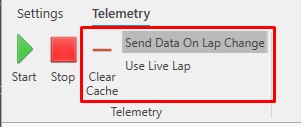
Send Data on Lap Change
By default the reader reads the last point of each channel sequentially and sends the information to the DMI. In configurations including a significant number of channels this might lead to a delay in the last values obtained. When the option to send data on lap change is selected, nothing is sent to the DMI until a lap change is detected. When the lap is detected the reader pulls all the data for the last lap, processes it and sends it to the DMI.
Use live lap
When the option to send data on lap change is selected, after the a lap change is detected the reader must find the time range of the last lap. By default the lap is found by looking at the lap with the most recent start time. The option to use the live lap removes this check and the reader pulls the data from a lap called "Live" in the data source.
Clear cache
For faster accessibility of the channels data, the channel accessors are cached in the reader memory. This could lead to incorrect values when the data source changes (i.e. the car is power cycled). The reader contains an algorithm to clear the cache automatically when a data source change is detected, however if the algorithm fails or incorrect values are displayed, this button allows the user to manually clear the cached channels.
Start/Stop Connection
To start and stop the connection to the telemetry stream use the buttons in the "Telemetry" section of the ribbon bar.
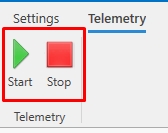
Data
The data tab shows the data received from the telemetry stream and the data that is transmitted to the DMI
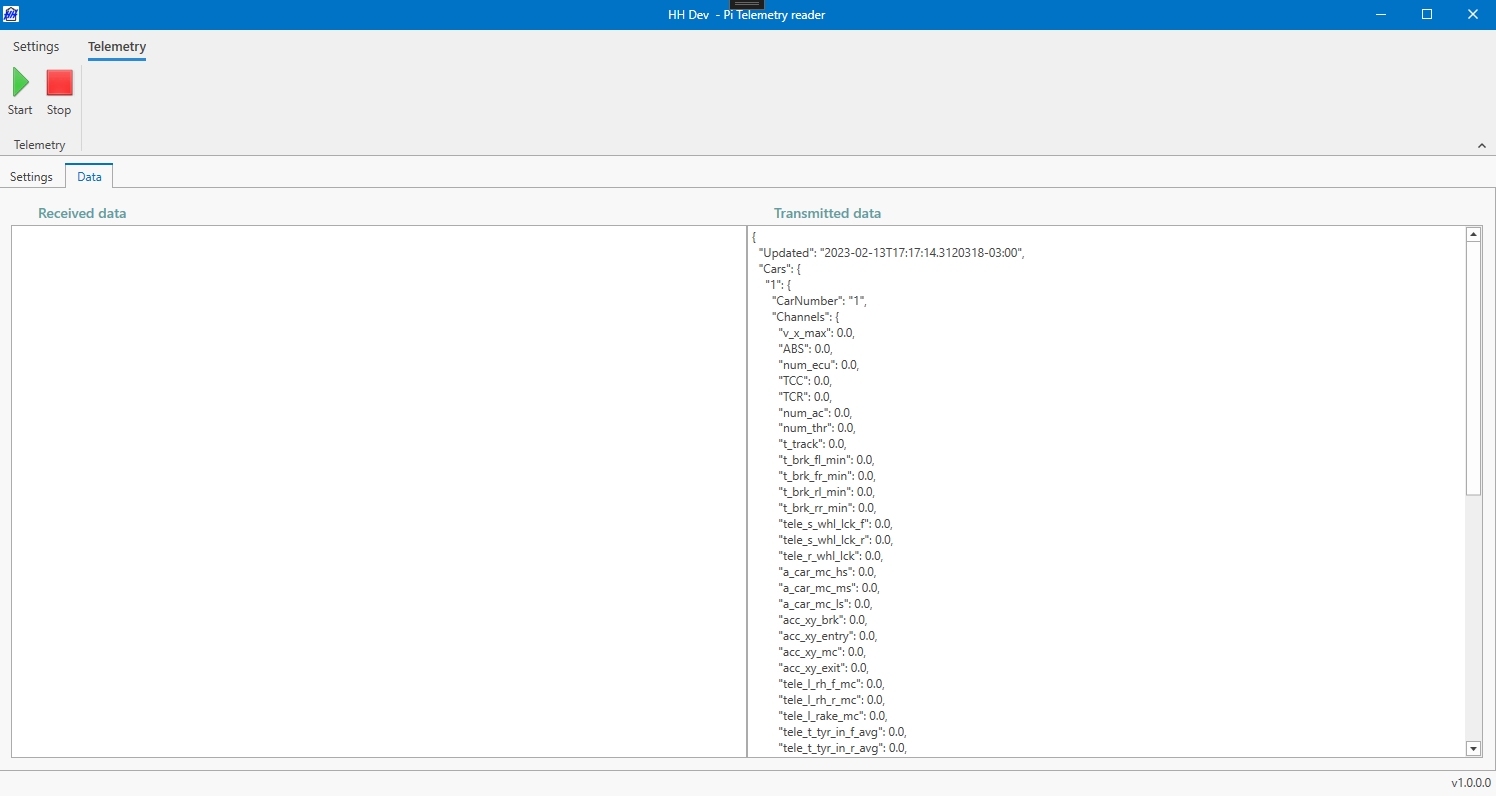
When the connection to the telemetry stream is successful, the "Received Data" section should display the latest received value. If the window stays empty, please troubleshoot the connection.
DMI Connection
Before connecting to the DMI, the connection settings must be established in the plugin options of HH Timing

The telemetry server host is the IP address of the computer running the RT reader. In case it is running on the same computer, use "localhost". The port always has to be set to "2018".
To connect/disconnect the telemetry reader use the buttons in the DMI ribbon bar.
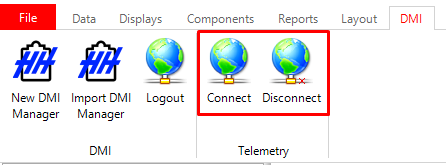
If the connection is successful, the DMI should display a green light in the connection status

The DMI allows the filtering of channels. By doing this, you can reuse a RT reader config but filter which channels are sent to Data Management. As mentioned above, the LapIndicator channel is use for calculations and therefore it should be included in the list of blocked parameters
